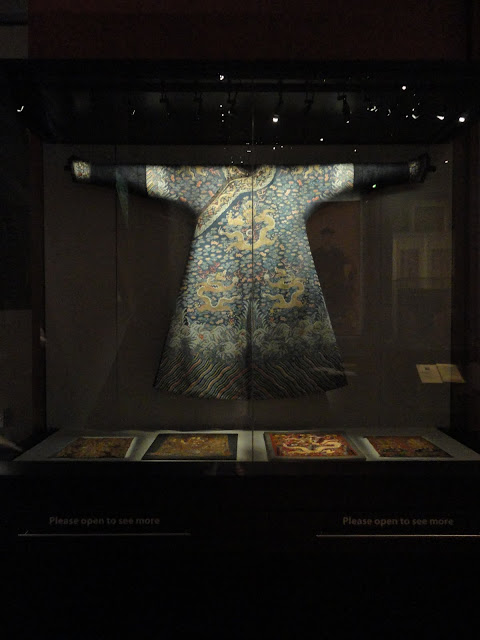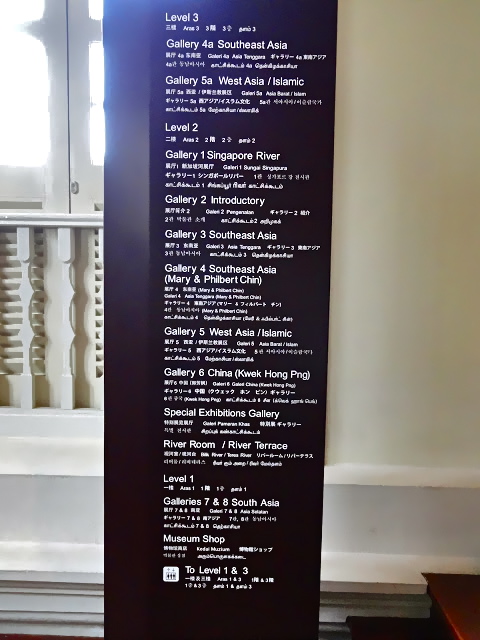This picture was taken from the carpark outside the museum. Lots are limited, and on a day of free admission, waiting up to 30 minutes for a lot is not uncommon.
A pity we arrived around 4pm, when the bulk of the activity was over. The exhibits however, more than made up for it, and though we spent at least 2 hours wandering around the numerous galleries, we managed to view only 80% of what's on display.
Since it's a sort of 'fun day', there was the obligatory food and drink stalls outside the entrance to the museum. There was also free ice-cream but it had run out by the time we arrived.
The boy and I shared a hotdog as I was feeling a little peckish.
 The numerous galleries you can find at the museum.
The numerous galleries you can find at the museum.At the foyer, there was a Supermighty Heroes of Asia exhibit for kids, featuring stories like the Journey to the West, Romance of the Three Kingdoms and Mahabharata. Needless to say, the boy enjoyed camwhoring with the 'I am a supermighty hero' backdrop while I was more anxious to get in to see the special exhibit.
The special exhibit, which will be on till April 2011, was Congo River: Arts of Central Africa.
Masks were heavily featured at this exhibit.
The mask below is most probably a panya ngombe mask reserved only for the most important Pende chief, and worn during cirumcision during initiations.

A bearded mask owned by Lega men. It belongs to a type called Lukwakongo which means 'death gathers in', and refers to the importance of the connection between the past and the present.

One of a set of seven mishi figures kept in a shrine house by an elder representing the members of a closely knit unit of an ancestress, her five sons and grandsons. This is Alunga, one of the grandsons, depicted as a double-faced mask sitting on a stool.

This figure with the elongated forehead was my favourite. It is a reliquary figure which would have been placed on top of a hollowed-out tree trunk containing the bones of ancestors.

I thought these were voodoo dolls, but they are in fact powerful protection figures (nkisi nkondi) used as beneficial intermediaries when dealing with otherwordly forces. They also served as a healing medium, and to conclude peace treaties between villages. To seal a contract, the two parties would hammer a nail or blade into the figure.


I liked the special exhibition a lot, and felt that it presented the dark (not in a bad sense) and mystical world of the Central African people.
And if you happen to get tired of merely looking at art, you can get busy creating your own likeness with the stamps and paper available. The finished masterpiece can be made to stand upright and displayed like a photo frame.

This is the boy's ...

... and this is mine.

Moving on to the other galleries, what caught my attention in the section on Indonesia was this Magic Bark Book (pustaha) containing magic formulae (tabas), oracles, medicinal receipes and instructions for carrying out rituals. It was believed that the knowledge contained within were for preserving life, destroying life, and the art of fortune-telling.

The meaning behind the bridge cloth (kain titian) of West Sumatra was something that also caught my attention. Part of the traditional wedding ceremony, it was made by joining two panels, one made by the bride's family, the other by the groom's family, symbolising their union. During the ceremony, the bride and the groom would walk towards each other along the cloth, finally meeting in the middle.

The larger-than-life-sized Guardians of the Underworld. Known as the Black and White Faces of Impermanence (Heibai Wuchang), the Tall and Short Ones, the Seventh and Eighth Lord, they are General Xie and General Fan, sometimes also venerated as gods of wealth by gamblers.

This lion ink stone was from Vietnam, the only Southeast Asian country to produce blue and white wares. The technique is believed to have originated in China but the stoneware they produced were quite different in appearance and feel.

The 17th century ceramic sculpture of Guanyin in a grotto with the boy pilgrim Shancai Tongzi and the dragon princess Long Nu. The lotus flowers rising from the waves represent purity.

This five-colors (wucai) dish from the Kangxi period, which was when the finest examples were produced, has the characteristic delicate designs and rich colors. The floral medallion depicting hydrangea, peony and lingzhi symbolises longevity and good fortune.

Depicted below are the various tools needed to produce a painting.

An album of various subjects painted by Bian Shouming, who was regarded as one of the 'Eight Eccentrics' who deviated from the orthodox mode of painting.

Lotus and Insects by Qi Baishi, an artist whose paintings had a strong connection with folk art. This painting show his mastery in gongbi (meticulous, detailed brushwork for the insects) and xieyi (free and exuberant brushwork for the flowers).

Fan painting is done on either paper or silk.
Bird and Bamboo by Du Jin, Bamboo and Rock by Shen Mingchen.

An emperor's robe and the fine detailed embroidery.



It's possible to spend half a day at the Asian Civilisations Museum as the place is rather huge and the galleries well-stocked. The above only scratches the surface of what you can find there and it's rare for me to say this, but this place is worth the ticket price. There aren't many new things to do in a small city like ours anyway.
Opening Hours
Monday: 1pm - 7pm
Tuesday to Sunday: 9am - 7pm (to 9pm on Fridays)
Admission Charges
Adult: $8
Concession: $4
(full-time students and those above 60 years old)
I highly recommend the joint admission ticket for this museum and the Peranakan Museum though.
Adult: $11
Concession: $5.50









No comments:
Post a Comment